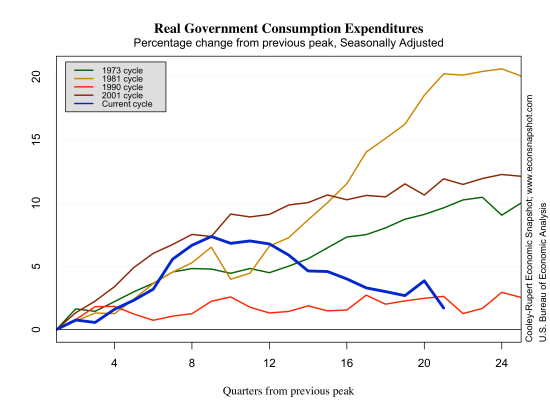Solid growth in employment
The increase in total nonfarm employment, +236,000 as seen in today’s Employment Situation, beat most analysts expectations, although January employment was revised down slightly, from +157,000 to +119,000, as seen in the Net Employment Change chart below.

Private sector employment was up +246,000 while the government sector continued to shed jobs, -10,000. State government was responsible for 80% of that decline. The largest gain came from private service workers, +179,000. Professional and business services added +73,000. Goods producing employment was also up, +67,000, led mainly by construction, +48,000, and in that sector the largest gain was in specialty contractors. Total employment continues to grow steadily, but is still not back to its level in December of 2007.

The unemployment rate ticked down from 7.9% to 7.7%, and at 12,032,000 there were about 300,000 fewer unemployed persons compared to last month. However, those unemployed more that 27 weeks edged up by 89,000. Overall there are about 4.7 million persons who have been unemployed more than 27 weeks.

The employment to population ratio was unchanged from last month at 58.6%, moreover, it was also 58.6% in February of 2012 and was close to that level three years ago. While this picture reveals no growth over the past year, it is not necessarily a sign that labor market is still under considerable duress. There are many factors that drive this statistic, such as decisions about entering the labor force, retiring, or staying in school. The point is that while the employment population ratio is indicator of labor market health, there are lots of things that drive it. The ratio at the beginning of the recession in December of 2007 may have been “cyclically” high, and now has adjusted to a new level. This can also be seen in the labor force participation rate, which actually declined slightly over the month, from 63.6% to 63.5%.



The Beveridge curve depicts the relationship between the reported vacancies and the unemployment rate. As is evident in the graph, the unemployment rate is much higher given the vacancy rate than it was before the last recession. The first red dot to the left shows that at the beginning of the recession the vacancy rate was about 3% (3 vacancies for every 100 employed) and the unemployment rate was under 5%. Today, the vacancy rate is just under 3% yet the unemployment rate is 7.7%. Why those unfilled vacancies remain unfilled given that level of unemployment remains an open question.




































